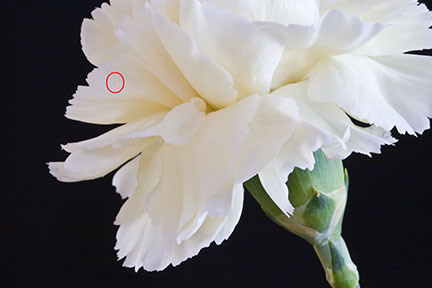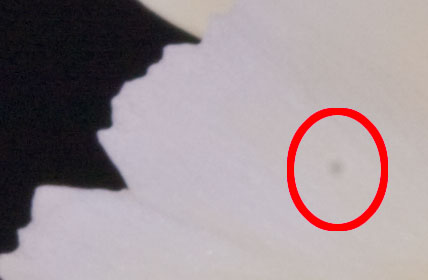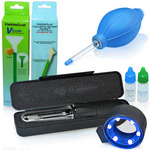Dust is your enemy. It’s important to keep your sensor clean and "schmutz-free!" Get the scoop on camera sensor cleaning, and keeping it clean.
What are those Spots?
Sensor dust is simply dust particles that adhere to the digital sensor of your camera. They can get onto your sensor when you change lenses. They result in dark gray "spots" on your image.

Dust spot
© Julie Waterhouse Photography

Close-up of the dust spot
© Julie Waterhouse Photography
Diagnosing Different Kinds of Dust: Mirror, Sensor or Lens?
If you see spots when you look through the viewfinder, they may be on your mirror, your lens or your sensor. To check where they are, take a picture of a blank, light-colored wall. Transfer the image to your computer, and magnify it to 100%, then scan it up and down, looking for spots.
If you find no spots, then the dust is most likely on your mirror, which lifts out of the way when the picture is taken.
If you do find a spot, then the dust is either on your lens or your sensor. If you switch lenses, and the spot is still there when you take another picture, then the dust is on your sensor.
How to Clean Your Sensor
Disclaimer
Cleaning your sensor yourself may void your camera’s warranty. You must be very careful not to scratch your sensor. Use any of the following methods at your own risk.
My two favorite tools for camera sensor cleaning are made by the company Visible Dust, and they are the Arctic Butterfly®, and the Sensor Loupe™.
The Arctic Butterfly is a brush with bristles that are battery powered to spin. As they spin, they build up a static charge. You then pass the brush close to the sensor (without actually touching it), and the dust particles are attracted to it and lift off the sensor.

Arctic Butterfly
Camera sensor cleaning
If the Arctic Butterfly fails to remove the sensor dust, then it likely contains a sticky substance, and you will have to get a little more aggressive with your camera sensor cleaning. For that kind of problem, I use a little plastic spatula made by Copper Hill Images wrapped with a Pec Pad (a clean, non-abrasive, specialty cloth pad), with a drop of Eclipse optic cleaner, and carefully wipe across the sensor.
To get a good view of your sensor, and immediately see whether your have eliminated all the sensor dust, I highly recommend the Sensor Loupe. It is a magnifying glass that fits over your sensor, and has lights around it so that you can clearly see a magnified view of your sensor.
How do you access the sensor in your camera?
Normally, when you detach your lens and look inside your camera, you see the mirror. The sensor is located underneath it. Most DSLRs have a camera sensor cleaning mode that you can turn on through the menu system. When activated, this mode locks the mirror up, and keeps it raised until the camera is turned off. The sensor behind the mirror is then exposed. To activate sensor cleaning mode, your battery must not be close to empty (it would be bad if you were poking around the sensor, and the mirror suddenly came crashing down because the camera battery died and shut off the camera!).
Self-cleaning
These days, the newer DSLR’s have a self-cleaning mode that activates whenever the camera is switched off. Since getting a camera with that feature, I haven’t been troubled nearly as much with sensor dust; it seems to be very effective.
Keeping your Sensor Clean
Cleaning your sensor is a hassle, so the best thing to do is to try to keep it clean. Here are a few tips for keeping the sensor dust away.
- 1. Change lenses quickly so the sensor is not exposed for long. Lens changing is the activity that is most likely to expose your sensor to dust.
- 2. Change lenses inside. If that is not possible, then turn your back to the wind and hunch over to avoid dust blowing in.
- 3. Turn off your camera and point it straight down when changing lenses. When the camera is switched on, the sensor creates a small charge of static electricity, which can attract sesnor dust. If you switch off the camera, the static charge dissipates and reduces the likelihood of getting more dust on the sensor.
- 4. Vacuum the dust from your camera bag frequently.
- 5. Store your camera with its back up, and make gravity work for you.
Next, you may want to visit our page on professional photography equipment to learn about the tools that I use.